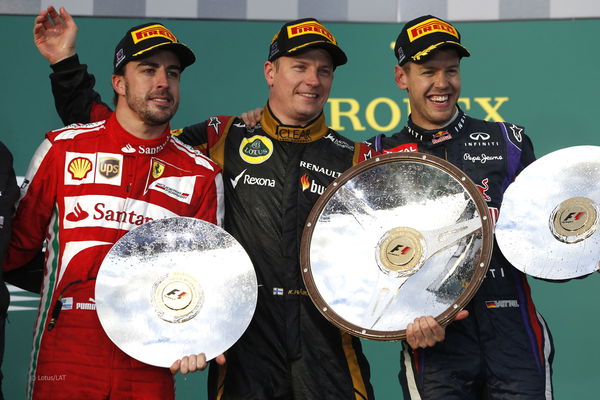Formula One’s Dying Breed of Drivers

Follow Us

via Imago
Albert Park, Melbourne, Australia Sunday 17th March 2013 Kimi Raikkonen, Lotus F1, 1st position, on the podium with Fernando Alonso, Ferrari, 2nd position, and Sebastian Vettel, Red Bull Racing, 3rd position. Photo: Glenn Dunbar/Lotus F1 Team ref: Digital Image _89P5052
The 2016 season has concluded and it gave us a new champion. As the season moved to an end, the sport’s two illustrious careers too came to an end. Felipe Massa had made the announcement in Italy while Jenson who so far insisted that he was “not retiring” from Formula One, finally acceded to walking away from the sport in Abu Dhabi. How much of it is the result of Ron Dennis coming out the loser in McLaren’s internal struggle is a different story.
So the two retiring men, both regarded as gentlemen, had different approaches and journies to F1 and achieved different things.
Jenson Button started his career at the age of 8 and moved to F1 in 2000 with Williams. He endured a long spell in Formula One spanning 17 seasons. In addition, Button had to wait a long time for his firsts: be it a podium or win. It finally culminated into a championship with Brawn GP in 2009 and after 7 years with Mclaren, he hung his JB helmet in F1 but I’m sure he’ll be still racing.
ADVERTISEMENT
Article continues below this ad
Felipe Massa, on the other hand, arrived in Formula One in 2002 on the back of blitzing various feeder series in Europe. This resulted in him earning a Ferrari contract placing him with Sauber and ultimately the Italian Squad from 2006 to 2013 where he almost became a champion. But, his magnanimity in 2008 championship defeat earned him a respect that’ll stick with him all through his career. Three years for Williams saw him rebuild the reputation he had somewhat lost while partnering Alonso and this year he graciously bowed out of the sport.

via Imago
Jenson Button and Felipe Massa
While both the men’s story in F1 is different from each other, the one thing common is that both belonged to affluent backgrounds. While Jenson was the son of British Rally Cross ace John Button, Massa hailed from a wealthy family and this allowed them to carry on their journey in Formula One.
This detail, however, is unimportant in the wake of the retirement of the two. Nonetheless, it highlights a nifty detail about the current crop of F1 drivers, as pointed out by Anthony Hamilton, that some of them are the last of a dying breed.
The breed he referred to is that of those who made it into the sport from less well-off and laidback background. Of the current stars only Hamilton, Alonso, Raikkonen and Vettel have come from families who did not have the money or connections to the racing world which could be leveraged to allow these stars to make it to Formula One.
It can be argued that Hamilton became a member of McLaren and Mercedes-Benz Young Driver Support Programme at the age of 13 which later on funded his progression into the expensive world of Motorsport. Vettel too landed himself a Red Bull Junior Team role at the age of 11. Despite such associations, it cannot be denied that the two began their journey with little support and money and the hardships they faced is in striking contrast to the new generation in the sport as well the ones coming in.
Look at the likes of Verstappen and Sainz who belong to racing families. Perez hails from a rich Mexican background and so does Guiterrez. The incoming Stroll has a father who has till date allegedly spent 80 million dollars on his son’s racing career and the highly rated Vandoorne whose father is a rich architect.
The point that Anthony Hamilton so emphatically raised and which is validated by one look at the grid is that the sport has become open only to the elite. Formula One as a sport had humble beginnings where anyone could enter as long as he had a car to race. But as the sport progressed and rules came in to ensure uniformity in the grid, it attained an organized structure which meant that only those conforming to the rules could race.

via Imago
Lewis Hamilton with father Anthony
The sport went from being a competition to a business. As the years progressed, F1 transformed into a show, an entertainment medium, because businesses saw it as a very lucrative ground to advertise their brands. This meant a lot of money was getting involved and the next step was grooming the drivers.
Bigger teams started employing scouts who would look for young talents in junior categories and then would fund their way to Formula One. This had a manifold impact on the lower categories as they saw money trickling down from F1 to them. Many tiers were created for a driver to progress from karting to F1. Gone were the days where drivers made it to Formula One at any point in their life and without any experience as long as they were fast. As a matter of fact, Graham Hill did not have a road license a year before making it into Formula One.
But while money is and always was an issue in F1, the creation of multiple levels made it exponentially expensive for a driver who had to prove his mettle before ultimately making it into Formula One.
The entire sport was organized right from Karting to Formula 3, GP3 and GP2 and finally F1. And the direct effect of it is that Racing has become expensive. Nowadays an aspiring Driver has to begin his career at the tender age of 8, compete in multiple levels of Karting from National to Regional and International Round before making a switch to the so-called Single Seater series like Formula 4 and Formula 3. After this, multi-year stints in GP3 and GP2 are a prerequisite in proof of oneself worthy of a Formula One seat.

via Imago
Pix Simon Clegg/Anglia Press Agency. Motor Racing, Lewis Hamilton – archive date 08/05/06. picture date 25/09/1998.
copyright picture/Anglia Press Agency/ 07768 793 434
FIRST WIN: LEWIS HAMILTON SHOWS OFF HIS FIRST EVER TROPHY AGED 8 AND A LETTER OF CONGRATULATION FROM MARK BLUNDELL. NAPA RATES APPLY
And all of this does not at any point of time comes cheap. Strong competition right from Karting days means spending top dollars to get top notch machinery that’ll allow a driver from not getting lost somewhere back in the grid.
ADVERTISEMENT
Article continues below this ad
Even if a driver is talented, he is expected to not only pay for his initial years but also bring in money for the team when he joins them either from the wallet of his father or that of a Sponsor who will be ready to shower the lad in money in return for painting him and his car with his company’s logo. And this requirement keeps on growing as you progress from one series to another and these days it has reached the levels of absurdity.
Take the case of erstwhile Ferrari Young Driver Academy member Raffaele Marciello who made it to GP2 after winning the European F3 series drove in GP2 for 3 years where this year he finished 4th overall but despite such a high achievement he has ruled out his chances of moving to F1. The reason? The move required for him to bring in money to the tune of 10-15 Million Dollars.
ADVERTISEMENT
Article continues below this ad
Similar is the case for Rio Haryanto who was shown the way out from backmarker Manor mid-season because he failed to raise the other half of alleged 14 Million Dollars agreed for a whole season.
All in all, it’s not any single individual or business entity’s fault that costs have run up so high. Wherever there’s competition, those with more money are bound to spend more that’ll allow them to gain an advantage over their rivals. Unless an effective cost cap is effected at different tiers, the likes of Hamilton and Raikkonen are the sole torch bearers of a breed that fought its way into the sport from almost nothingness. Until measures are taken to curb the influence of money on the sport, the gates to motorsport will remain strictly closed for this breed.
